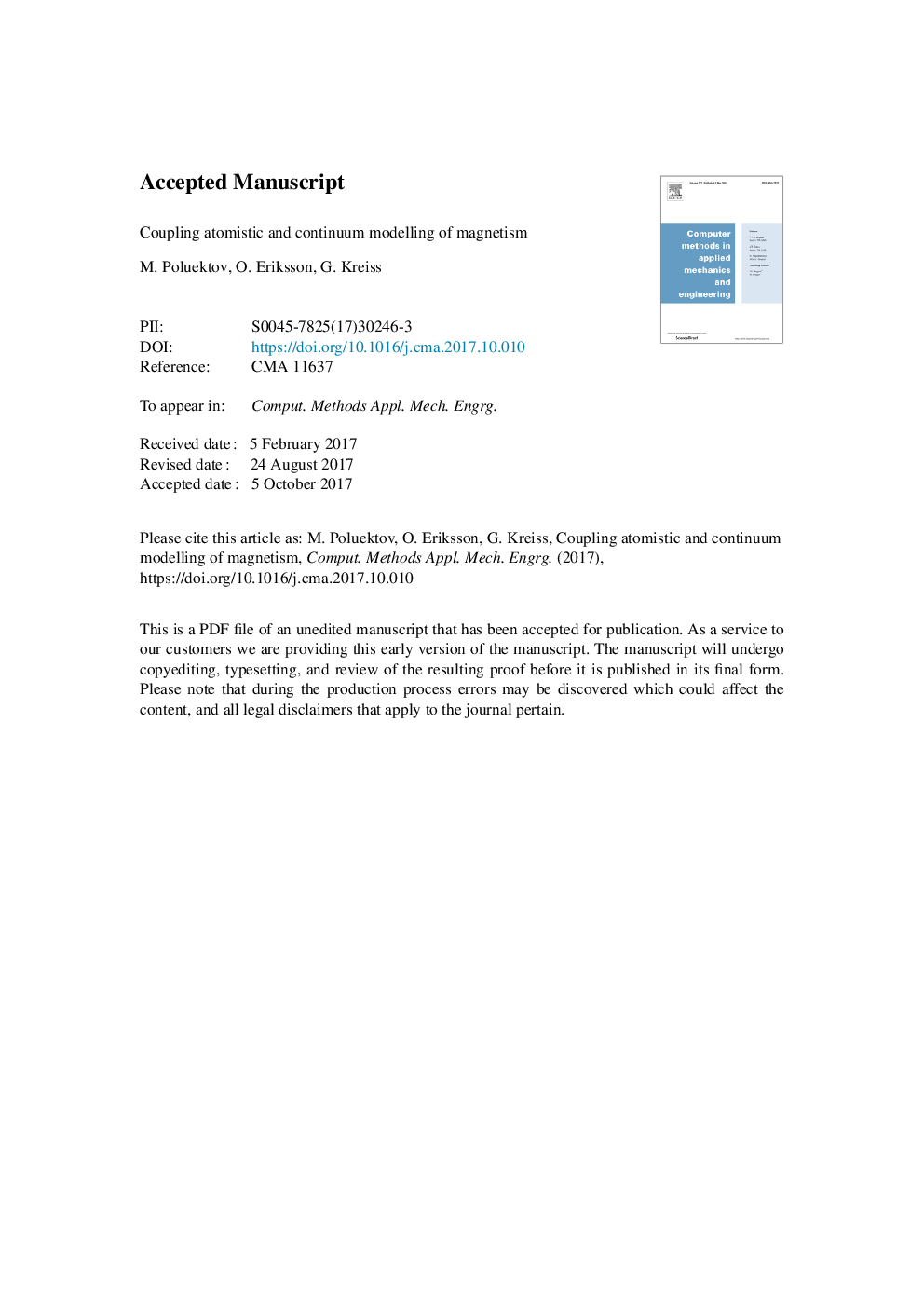| کد مقاله | کد نشریه | سال انتشار | مقاله انگلیسی | نسخه تمام متن |
|---|---|---|---|---|
| 6915738 | 1447406 | 2018 | 75 صفحه PDF | دانلود رایگان |
عنوان انگلیسی مقاله ISI
Coupling atomistic and continuum modelling of magnetism
ترجمه فارسی عنوان
مدلسازی اتم سازه و پیوندی مغناطیس
دانلود مقاله + سفارش ترجمه
دانلود مقاله ISI انگلیسی
رایگان برای ایرانیان
کلمات کلیدی
پویایی مغناطیس، مدل سازی چند بعدی، پیوند زدایی اتومنتیک، دیوارهای دامنه نیروهای ارواح،
ترجمه چکیده
در این مقاله، یک روش چند بعدی چند بعدی چند منظوره برای پویایی مغناطیسی ارائه شده بر اساس انرژی مبتنی بر اتمیستی-پیوسته ارائه شده است. ویژگی اصلی این روش، تقسیم مینیمم شده بین توضیح مختصات محلی و توصیف اتولوژیک غیر محلی است (که در آن نزدیکترین تعاملات متقارن همسایه وجود دارد). خطا در رابطۀ اتومیستی-پیوسته با ایجاد یک ناحیه متوسط که متشکل از اتم های گذار است، با یکدیگر متصل به مناطق همجوار و اتمیستی است. هنگامی که مش از منطقه پیوستگی به مقیاس اتومیستی در رابط یکپارچه اتمیستی تصفیه شده است و یک طرح حفاظتی زمان گام به گام برای کل محاسبات دامنه استفاده می شود، روش صرفه جویی در انرژی کل سیستم است. یکی از ویژگی های دوم این روش معرفی یک باند کمینه در ناحیه ی اتومیستی-پیوسته است که موج های فرکانس بالا را جذب می کند که در غیر اینصورت از رابط بازتاب می شوند و در نتیجه به خطا در داخل منطقه اتومیستی کمک می کند. چندین نمونه از حرکت دیوار دامنه و انتشار موج چرخش در ساختارهای یک و دو بعدی برای نشان دادن کاربرد روش و بررسی محدودیت های آن استفاده می شود.
موضوعات مرتبط
مهندسی و علوم پایه
مهندسی کامپیوتر
نرم افزارهای علوم کامپیوتر
چکیده انگلیسی
In this article, a new energy-based atomistic-continuum partitioned-domain multiscale method for magnetisation dynamics is proposed. The main feature of the method is the minimised mismatch between the local continuum description and the non-local atomistic description (in which non-nearest neighbour interatomic interactions are present). The error at the atomistic-continuum interface is minimised by constructing an intermediate region consisting of transition atoms, which interact differently with the neighbouring atomistic and continuum regions. When the mesh of the continuum region is refined to the atomistic scale at the atomistic-continuum interface and an energy-conserving time-stepping scheme is used for the entire computational domain, the method conserves the total energy of the system. The second feature of the method is the introduction of a damping band at the atomistic-continuum interface, which absorbs high-frequency waves that are otherwise reflected from the interface and thereby contribute to the error inside the atomistic region. Several examples of domain wall motion and spin wave propagation in one- and two-dimensional structures are used to illustrate the applicability of the method and to investigate its limitations.
ناشر
Database: Elsevier - ScienceDirect (ساینس دایرکت)
Journal: Computer Methods in Applied Mechanics and Engineering - Volume 329, 1 February 2018, Pages 219-253
Journal: Computer Methods in Applied Mechanics and Engineering - Volume 329, 1 February 2018, Pages 219-253
نویسندگان
M. Poluektov, O. Eriksson, G. Kreiss,
